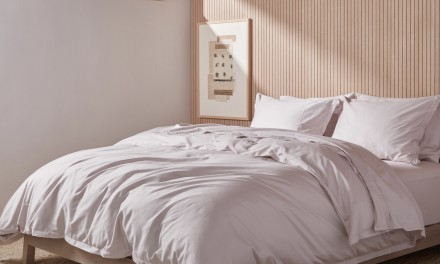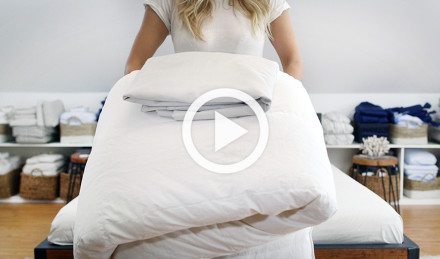If you're in the market for new bed linens or are drawn to minimalist, streamlined home design, you may have come across European bedding when browsing products online. But what is European-style bedding, exactly, and how is it different from its American counterpart?
Follow along for helpful tips on how to layer your bedding European-style and the best bed sheet fabrics from Europe.
What Is European Bedding?
What Is European Bedding?
European bedding is bed linens made either in Europe or from plant fibers grown in European countries. This includes sheets, pillowcases, duvets and other types of bedspreads. The concept also refers to the specific methods Europeans use to make their beds, which differ slightly from American bed-making techniques.
European vs. American Bed-Layering Techniques
European bed-layering stands out for its simplicity. The minimalist technique typically consists of a fitted sheet on the bottom and a duvet on top. American-style bed-making, on the other hand, often calls for a fitted sheet on the bottom, followed by a flat sheet, then a comforter and maybe a throw blanket on top.
Of course, there's no right or wrong way to layer a bed, but making it each morning is a worthwhile ritual. See our blog to learn Why Making Your Bed Matters.
No Top Sheet
European vs. American Bed-Layering Techniques
European bed-layering stands out for its simplicity. The minimalist technique typically consists of a fitted sheet on the bottom and a duvet on top. American-style bed-making, on the other hand, often calls for a fitted sheet on the bottom, followed by a flat sheet, then a comforter and maybe a throw blanket on top.
Of course, there's no right or wrong way to layer a bed, but making it each morning is a worthwhile ritual. See our blog to learn Why Making Your Bed Matters.
No Top Sheet
European sheet sets often don't come with a top sheet. Hotels across Europe usually make their beds with only fitted sheets and European duvet covers.
A top sheet can add an additional layer of warmth and help keep your bedspread clean. However, lots of folks don't like the tight feeling of having the top sheet tucked in at the bottom. When it's not tucked in, the sheet might get kicked into a crumpled pile by morning anyway.
Forgoing the flat sheet is ultimately a matter of personal preference. Explore this European bedding theory further in our article, What Is a Top Sheet, and Do You Actually Need One?
Seasonal Layers
European-style bedding evolves throughout the year to account for warm weather, chilly temps and changes in humidity. For instance, a lightweight down-filled duvet will probably suffice in the summer. In the fall and spring, you might reach for a knit blanket. The winter months may call for an additional European bedspread.
Check out our guide to learn How to Layer Your Bed Like a Stylist.
Scandinavian-Style Double Duvet
Making a bed with two duvets is customary in Scandinavia, especially for those who share a bed with a partner. The idea behind this Scandinavian bedding style is that you'll have multiple layers of warmth but also plenty of slack while snuggling up together. Then when you want to fall asleep, you can wrap yourself comfortably in your own comforter without disturbing the other person.
See our Guide to Duvets and Duvet Covers for insight into the different types of comforters.
How to Make a Bed European-Style
Now that you're up to speed on double duvets and European-style bedding, let's go over how to make your bed like a European.
Place the fitted sheet on your mattress, pulling it down tightly on the sides and corners to make sure it's smooth.
Stuff the duvet into its cover, making sure to secure the corners to prevent it from shifting around.
Place your duvet on your bed with the zipper or button closure at the foot, making sure it hangs evenly on either side and slightly over the bottom.
Fold the top of the duvet down toward the foot of the bed, leaving about 12 inches of the fitted sheet exposed at the head.
Cover your bed pillows with pillowcases and shams.
Place the pillows you sleep with against the headboard, then place the sham-covered pillows in front.
Instead of propping up your pillows, you can also lay them flat for a simplified look. See our tutorial on How to Make Your Bed for more tips.
How to Make a Bed European-Style
Now that you're up to speed on double duvets and European-style bedding, let's go over how to make your bed like a European.
Place the fitted sheet on your mattress, pulling it down tightly on the sides and corners to make sure it's smooth.
Stuff the duvet into its cover, making sure to secure the corners to prevent it from shifting around.
Place your duvet on your bed with the zipper or button closure at the foot, making sure it hangs evenly on either side and slightly over the bottom.
Fold the top of the duvet down toward the foot of the bed, leaving about 12 inches of the fitted sheet exposed at the head.
Cover your bed pillows with pillowcases and shams.
Place the pillows you sleep with against the headboard, then place the sham-covered pillows in front.
Instead of propping up your pillows, you can also lay them flat for a simplified look. See our tutorial on How to Make Your Bed for more tips.
Popular European Bedding Fabrics & Products
Now that you know what European-style bedding pieces you need to make a bed, let's discuss the different fabrics and materials that come from European countries.
European Linen
Popular European Bedding Fabrics & Products
Now that you know what European-style bedding pieces you need to make a bed, let's discuss the different fabrics and materials that come from European countries.
European Linen
Linen is among the most popular bedding textiles in the world, thanks to its inherently breathable structure and increasingly soft feel. The fabric is sourced from the fibers of flax plants, which are often grown in France, the Netherlands or Belgium.
Also known as linseed, the unique climate in these Southwest European countries allows the plants to grow taller than they would in other regions. The notably long, strong fibers give linen bedding a superior quality — you can tell the difference the moment you touch it.
For more on this European bedding staple, see our blog, Why Is European Flax Linen the Best in the World?
Turkish Cotton
Turkey is a transcontinental country with territories in both Western Asia and Southeastern Europe. While it depends where the plants were grown and where the fabric was produced, Turkish cotton is sometimes considered a type of European cotton.
Like European linseed, cotton plants grown in Turkey have extra-long fibers. Also known as long-staple fibers, these thread-like strands make for extra-strong and incredibly soft bedding fabrics.
For a deeper dive, read our article, What Is Turkish Cotton?
Euro Pillows and Shams
Euro pillows (also known as European pillows) are another European bedding staple. These square-shaped decorative cushions are typically 26 x 26 inches. As with outward-facing American bed pillows, they're covered with shams and placed in front of the pillows you sleep with.
In addition to concealing your regular pillows when making the bed, Euro pillows make excellent backrests while reading or watching TV in bed. They're also attractive choices for styling living room furniture, window seats and benches.
Read our guide for tips on styling with euro shams: What Are Euro Shams and Euro Pillows? Sizes, Materials, & More
Textiles Made in Portugal
European bedding sometimes refers to bed linens produced in Europe. For instance, some of the best manufacturers are located in Portugal — a country with a rich history of fabric-making and trading. Dating all the way back to the 18th century, the Portuguese textile industry is known for high-quality products with artisanal attention to detail.
To learn more about European-style bedding made in Portugal, see our article, Portuguese Textiles: A Rich History.
Where to Buy High Quality European Bedding
Feeling inspired by European-style bedding and fabrics? You've come to the right place. Parachute is proud to carry a wide range of bed linens made from flax fibers and long-staple cotton grown in Europe.
From Euro pillows and linen bedspreads made in Portugal to Turkish cotton duvet covers and European sheets, you'll find what you're looking for here. What's more, the top sheet is always optional when you buy a set.
Shop the bedding collections today!
Read Next:
Where to Buy High Quality European Bedding
Feeling inspired by European-style bedding and fabrics? You've come to the right place. Parachute is proud to carry a wide range of bed linens made from flax fibers and long-staple cotton grown in Europe.
From Euro pillows and linen bedspreads made in Portugal to Turkish cotton duvet covers and European sheets, you'll find what you're looking for here. What's more, the top sheet is always optional when you buy a set.
Shop the bedding collections today!
Read Next:











